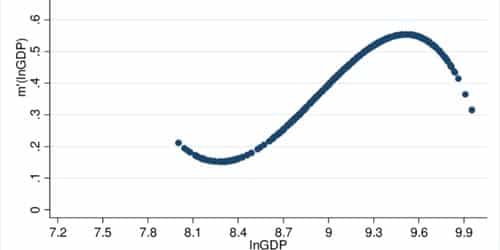The elasticity of a good or service shows how sensitive it is to changes in its price. To put it another way, when the price of something changes, it means that a source of income has ended. When price changes have little effect on sales volume, this is called negative elasticity. On the other hand, when price changes have a big effect on sales volume, this is called positive elasticity. In this piece, we’ll discuss the importance of the income elasticity of demand.
Income Elasticities
Income elasticity of demand is a measure of the sensitivity of demand to changes in income. It can be calculated by dividing the percentage change in quantity demanded by the percentage change in price.
If there is an increase in price and you wish to know its income elasticity, use this formula:
Qd/Pd =
(1 – e) / (1 + e)
Where Qd is your demand for the product at price Pd, or Qm/Pm if it was an increase in quantity demanded instead, and e is your estimated elasticity value (e).
You may also see this as simply ΔQ/ΔP or ΔQ/$—this means all other factors being equal, as long as each variable’s value stays constant, then this equation will be true regardless of whether those variables are measured on a per-unit basis or total dollar amount basis.
If both variables stay constant yet grow, there will still be inequality. Although one variable has risen more than the other (and thus should cause less impact), this does not necessarily mean that another factor caused more harm than expected since both values rise together during inflationary periods when prices rise faster than wages over periods measured by standard life expectancy.
For example, if you have a flat tire on your car and you need to buy a new one at $50, then that is an increase in quantity demanded, but if you were to buy two tires instead of one (each costing $50), then this would be a price increase.
However, if there were a change in income due to inflation or deflation, this would affect the demand curve since people with higher incomes can afford more than those who earn less per hour—thus, their relative demand levels change depending on how much they make.
The Income Elasticity of Demand
Income elasticity of demand is the measure of the responsiveness of demand to a change in income. The higher this number, the more responsive your demand for something. Less-responsive means that if you increase your income, you will buy less of that item until it becomes equal to zero (or at least not buy any more).
If the income elasticity of demand for coffee is positive, then the consumption of coffee is deemed normal because it is a good that most people want or need regardless of their income.
However, coffee may be inferior if itselasticity income is negative, meaning that as earnings rise, fewer individuals drink coffee. This would indicate that not everyone views coffee as a necessity.
Coffee is a Giffen good if your income elasticity of consumption is zero. Giffen goods are rare and have the unique property that their demand increases as people’s incomes decrease. This is because they are luxury items, and as people’s earnings drop, they switch to other things they need more.
If the demand for coffee were perfectly priced inelastic, then a price decrease would not affect the quantity demanded.
In other words, if you reduce your monthly budget by $100 and decide to spend it on coffee instead of something else (like buying a new car), then the amount spent on coffee would remain unchanged; however, because people are more likely to buy more when their incomes rise than when they fall—because they have more money left over after paying bills—the overall impact on total consumption is small; consumers will still buy about as much overall as before.
What Does It Mean When Income Elasticity is 1?
Income elasticity measures how sensitive demand is to changes in income. High elasticity suggests demand fluctuates a lot when income changes; low elasticity means demand changes little.
Suppose income elasticity is 1, and demand for goods changes by the same amount as the change in income. If you earn $10 and spend $5 on pizza, your demand for pizza will be 5 units per week.
If you earn $100 and spend $10 on pizza, your demand for pizza will be 10 units per week. When income elasticity is greater than 1, demand changes by more than the change in income. If you earn $10 and spend $5 on pizza, your demand will be 5 units per week.
If you earn $100 and spend $10 on pizza, your demand will be 10 units per week. When elastic income is less than 1, demand changes by less than the change in income. If you earn $10 and spend $5 on pizza, your demand will be 5 units per week. If you earn $100 and spend $10 on pizza, your demand will be 9 units per week.
When income elasticity is 0, it means that demand doesn’t change at all when income changes. If you earn $10 and spend $5 on pizza, your demand for pizza will be 5 units per week. If you earn $100 and spend $10 on pizza, your demand for pizza will be 5 units per week as well.
Examples of Income Elasticities
Income Elasticity of Demand for Coffee
The income elasticity of demand for coffee is -0.05. If a price increase causes demand to drop 5%, the change in demand will generate a 5% price drop.
In other words, if you increase your monthly budget by $100 and spend it on coffee instead of something else (like a new car), the amount spent on coffee would fall from $1,000/month to $900/month.
However, because people are more likely to buy more when their incomes rise than when they fall—because they have more money left over after paying bills—the overall impact on total consumption is small; consumers will still buy about as much overall.
Accordingly, the income elasticity of demand for coffee is -0.05.
If you increase your monthly budget by $100 and you decide to spend it on coffee instead of something else (like buying a new car), then the amount spent on coffee would fall from $1,000/month to $900/month; however, because people are more likely to buy more when their incomes rise than when they fall—because they have more money left over after paying bills—the overall impact on total consumption is small; consumers will still buy about as much overall as before.
Calculate Income Elasticity of Demand
If you are unfamiliar with income elasticity of demand, it is a measure of how much the quantity demanded of a product changes when the price of that product changes. This can be calculated as:
For example, if the price falls by 20% and the quantity demanded rises by 10%, then income elasticity:
Income Elasticity = (Actual Change in Quantity Demanded) / (Actual Change in Price) = 1%.
The higher this number, the more responsive your demand for something. Less-responsive means that if you increase your income, you will buy less of that item until it becomes equal to zero (or at least not buy any more).
Coffee’s income elasticity is positive because everyone requires it. Negative income elasticity shows that some people value coffee less than others, but this does not suggest a worse standard of living. Coffee is a Giffen good
Depending on available information, You calculate income elasticity in various ways.
A measure of how responsive the demand for a product is to changes in income. If the demand for a good rises with income, then it’s an elastic good that everyone wants or needs. If demand for a good declines as money rises, then that good is an inelastic good since some individuals don’t want or need it.
Importance of Income Elasticity of Demand
Among the many importance of income elasticity of demand are the following:
Income elasticity measures how sensitive demand is to changes in income. It can be used to determine the impact of price changes on sales and other variables that affect consumers. Income elasticity may also be used in pricing strategies, such as when retailers set prices based on other factors besides their cost (for example, how much they are willing to pay for an item).
When the income elasticity is positive, a direct relationship exists between income and demand for a product. For example, if your household income increases by $1,000 per year, then you will likely buy more cars in that year than you did before. When the income elasticity is negative, there is an inverse relationship between income and demand for a product.
For example, if your household income increases by $1,000 per year, then you will likely buy fewer cars in that year than you did before. When the income elasticity is zero or very close to zero (less than 1% change), there is no relationship between income and demand for a product. For example, if you buy food for your family at the grocery store and your budget does not increase or decrease based on your available money.
In general, the income elasticity of a product will be greater than 1 if there is an increase in price and demand. When a product’s price rises, people will likely buy more of it because they have more money.
Income Elasticity and Cross Elasticity of Demand
Income elasticity of demand measures the responsiveness of demand to changes in income. It’s a measure of the degree to which demand for a good responds to changes in its price.
For example, imagine you’re selling apples at $1 per pound and oranges at $2 per pound. If your customers can afford both apples and oranges but choose only one because they have limited funds left over after spending on food (like apples), your income elasticity will tell us how much people would be willing to pay for each item—$3 for an apple versus $4 for an orange if they don’t care about quality or taste.
In other words, if the price of apples increases by 10% and demand for apples decreases by 15%, then we know that income elasticity is -1.5.
Conclusion
Income elasticity is one of the most important concepts in economics. It’s also one of the most misunderstood! Income elasticity measures how sensitive your income is to changes in other factors that affect it, such as wages or prices.
For example, if you get a raise at work but your boss doesn’t raise the price of a product you buy from him, and he doesn’t increase his prices on other items either, then we say that this situation will not affect your income because these two factors are perfectly inelastic for each other and have balanced effects instead of being positively or negatively correlated (or “causal” relationships).
I hope this post has helped you understand the concept and importance of income elasticity of demand.
Income Elasticity FAQs
What are the Importance of Income Elasticity of Demand?
The Importance of Income Elasticity of Demand includes:
- Income elasticity measures how sensitive demand is to changes in income.
- It can be used to determine the impact of price changes on sales and other variables that affect consumers.
- Can also be used in pricing strategies, such as when retailers set prices based on other factors besides their cost.
What is the formula for calculating income elasticity of demand?
Income Elasticity = (Actual Change in Quantity Demanded) / (Actual Change in Price)






